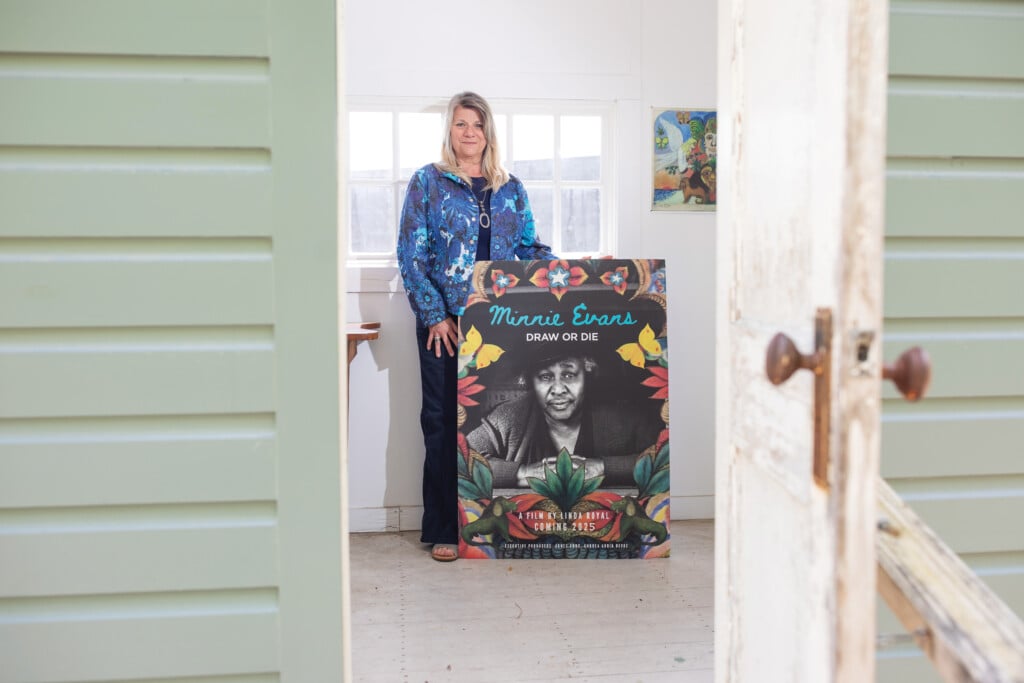‘Draw or Die’
Linda Royal unveils documentary on Minnie Evans
A 1991 Arts Magazine article described Minnie Evans’ artistic vision as “a prayer in praise of the power of love, the beauty of our own hearts, and the wonder of life.”
This sentiment and so much more is echoed in Minnie Evans: Draw or Die, a one-hour documentary on the local artist directed and produced by LINDA ROYAL, who also created and produced STRAWS, among other documentaries.
Royal was part of a nearly all-female team for this project, including Wilmington cinematographer BLAIRE JOHNSON (A Chef’s Life), ELIZABETH PENTON (a former University of North Carolina Wilmington adjunct professor of art history and anthropology as well as the film’s co-producer and art adviser), ANNETTE FREEMAN (consulting producer, and an Emmy Award winner), and NURI MUHAMMAD (Cape Fear Community College) and TIA ADKINS (UNCW), who are both recent local film school graduates.
BERTHA BOYKIN TODD provided historical details, and former Cameron Art Museum director ANNE BRENNAN provided insight into the Airlie Gardens gatehouse, which served as Evans’ studio (a replica of which is at the museum’s grounds and shown above.)
The film itself features Evans’ great-granddaughter, BEVERLY EVANS, MARVA ROBINSON (director of the Williston Alumni Community Choir, which performed in the film), and, portraying young Minnie, GLOW Academy student NEVAEH ALLEN.
“There’s something very powerful about Minnie Evans,” Royal says, “and I think we all need something uplifting and inspirational.”
Royal discovered the artist and her work seven years ago, when she and her husband got married at Penton’s grandparents’ home in Wilmington. While she got dressed and ready for the big day, she took in the art on the walls that showcased a myriad of subjects: angels, rainbows, and devils, to name a few. She says she wanted to learn more, and she got her chance when Cameron Art Museum screened The Angel That Stands By Me (1983), which is part of a series on contemporary folk artists.
“After that, I just thought she deserved to have another film being made about her so her art can reach new audiences,” Royal says.
Despite Evans’ art traveling all over the country to be featured in exhibitions at notable museums – even today, years after her death in 1987 – her name is largely unknown except by those who are particularly interested in art from female and African American artists, Royal says. Until recently, many mistakenly put her work in folk or “outsider” art categories, but now she is mainly referred to as a self-taught visionary artist.
Evans was born in Pender County in 1892 but moved with her mother to her grandmother’s home in Wilmington soon after. She didn’t start to really develop her art until the age of forty-three, having been purportedly urged on by repetitive dreams she claimed were sent to her by prophets. In 1944, she said she’d heard a voice that hinted she must “draw or die.” To Royal, this was proof positive that anyone could nurture their creative spirit at any age. Over the course of her career as an artist, Evans drew an estimated 3,000 pictures using found and donated materials, many of which depicted Wilmington staples and landmarks like Airlie Gardens, where she would often practically give her art away.
“When she came home after days like that, she was just Mama Minnie to her children and family,” Royal says.
While researching Evans during the COVID-19 pandemic, Royal unearthed taped discussions between her and photographer Nina Howell from the 1960s and 1970s preserved in the Smithsonian Museum of American Art’s archives.
“A big part of this film is about the friendship between these two women,” Royal says.
The film utilizes conversations between Evans and Howell to reveal the former’s resilient spirit, as well as images, some archival, that highlight work and life stories from both artists. Institutions like the Cape Fear Museum provided many helpful images. These resources also depicted what was going on during different parts of their lives, such as historically significant events like the Wilmington massacre of 1898 and World War II. Creating the foundation for this film, which is Royal’s first truly biographical piece, and bringing it to life turned out to be a complex process, she says. Between research into the history of the area and Evans, interviewing her family members, and filming scenes to reenact parts of her life, the documentary has been in the making for three and a half years.
The project still requires some work before it can be truly finished, even after a successful screening at CAM April 13. Outlying tasks include adding subtitles or closed captions, completing the sound mix, and fundraising for distribution costs. Royal credits Lighthouse Films with the color work and archival image restoration, which she says helped a lot with the expense of making the film. The project also has a 501(c)(3) fiscal sponsor in the Southern Documentary Fund and received other donations and grants.
 “It’s a tough time for independent filmmakers trying to raise money,” she says.
“It’s a tough time for independent filmmakers trying to raise money,” she says.
When it is complete, art museums across the country may be interested in screening it like CAM did, as the film demonstrates that a lot of interest was given to Evans’ work through gallery exhibitions over the years. Royal also has plans to enter it in film festivals like Cucalorus Film Festival, where several of her past projects have been shown.
“We would love to be able to have it broadcasted, but it’s too early to tell,” she says. “We’ll see how it goes at the film festivals. A lot of the time that can help determine where the film will end up.”
In the meantime, there are also plans in place to screen the finished film in schools, which Royal did with sections of Draw or Die at Masonboro Elementary School’s fifth-grade classes. Royal was impressed by their feedback on Evans’ work, so she is hopeful to provide other schools with educational guides for art teachers to explore the methods Evans applied throughout her career. The goal of this undertaking would be to start regionally and eventually expand nationwide.
After a successful filmmaking career, Royal thinks that Minnie Evans: Draw or Die will be her last major project unless she comes across another topic or subject that she feels particularly passionate about. There is still plenty to do with this one, though, so it will be some time yet before she moves on.
“Female artists tend not to get the same recognition as their male counterparts, even now,” Royal says, “especially African American women from the South. Hopefully, sharing this film will change that and help bring more people in to benefit the whole area.”
To view more of Katelynn Watkins’s work, go to k-watkins.com/bylines.
To view more of photographer Madeline Gray’s work, go to madelinegrayphoto.com.
Want more WILMA? Click here to sign up for our WILMA newsletters and announcements.




